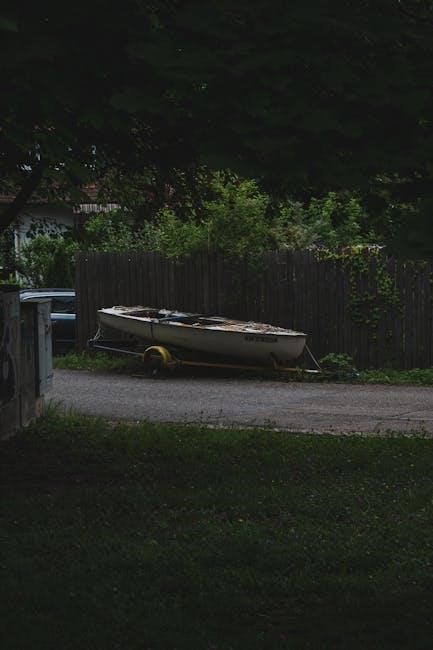Boat trailer bunk guide ons are essential accessories that simplify the process of aligning your boat with the trailer. They provide visual and physical guidance, ensuring a secure and effortless fit.

Why Boat Trailer Bunk Guide Ons Are Important
Boat trailer bunk guide ons are crucial for ensuring safe and efficient boat loading and unloading. They eliminate the frustration of aligning your boat with the trailer, providing clear visual cues and physical guidance. This reduces the risk of damage to both the boat and trailer, especially during nighttime or low-visibility conditions. Guide ons also help prevent costly scratches and dings caused by improper alignment. By streamlining the process, they save time and effort, making boating more enjoyable. Additionally, they enhance safety by minimizing the risk of accidents during loading or unloading. Overall, bunk guide ons are a practical investment for any boat owner, offering convenience, protection, and peace of mind.
- Prevent alignment frustration and potential damage.
- Provide clear visual guidance for safe loading/unloading.
- Protect the boat and trailer from scratches and dings.
- Save time and effort, enhancing the overall boating experience.
Types of Boat Trailer Bunk Guide Ons
Boat trailer bunk guide ons come in two main types: bunk-style and pole-type. Bunk-style guide ons provide support and alignment, while pole-type guide ons enhance visibility during loading.
Bunk-Style Guide Ons
Bunk-style guide ons are a popular choice for boat trailers, offering both support and alignment assistance. These guides are typically mounted directly onto the trailer’s bunk system and feature carpeted or padded surfaces to protect the boat’s hull. They are designed to cradle the boat, providing a snug fit and reducing the risk of damage during loading and unloading. One of the key advantages of bunk-style guide ons is their ability to minimize friction and prevent scratches. They also help maintain proper alignment, ensuring the boat sits securely on the trailer. Installation is relatively straightforward, and they are suitable for various boat types, making them a versatile option for many trailer setups.
Pole-Type Guide Ons
Pole-type guide ons are another popular option for boat trailers, offering a sleek and functional design. These guides consist of vertical or angled poles that extend from the trailer, providing clear visual cues to help align the boat during loading. They are often made of durable materials like galvanized steel or aluminum, ensuring longevity and resistance to corrosion. One key advantage of pole-type guide ons is their visibility, especially when the boat is not on the trailer. They can also be equipped with lights for enhanced visibility in low-light conditions. Additionally, some models are adjustable, allowing users to customize the height and angle to suit their boat’s specific needs. This versatility makes them a great choice for boaters seeking a practical and easy-to-use solution. However, they may require more maintenance than bunk-style guides.
How to Install Boat Trailer Bunk Guide Ons
Installing boat trailer bunk guide ons is straightforward. Measure the trailer, align the guides, and secure them tightly. Ensure proper fitment for safe and easy loading.
Preparation and Tools Needed
Before installing boat trailer bunk guide ons, gather essential tools like a tape measure, wrench, and drill. Measure the trailer’s frame to determine the best placement for the guides. Ensure the boat is aligned properly with the trailer bunks to confirm fitment. Clean the installation area to prevent debris interference. Assemble all components, including brackets and bolts, and consult the manufacturer’s instructions for specific requirements. Double-check that the boat is securely supported, either on the trailer or with jack stands, to ensure safety during the installation process. Having everything prepared beforehand will streamline the process and minimize delays. Proper preparation ensures a secure and accurate installation of the guide ons, enhancing trailer and boat alignment for safe towing and launching.
Measuring and Aligning the Guide Ons
Accurate measurement and alignment are critical for proper installation of boat trailer bunk guide ons. Measure the width of your boat’s beam and compare it to the trailer’s frame to ensure the guides fit securely. Align the guide ons symmetrically on both sides of the trailer, ensuring they are evenly spaced and parallel to the boat’s hull. Use a tape measure and level to confirm proper positioning. Mark the trailer’s frame where the guide ons will be mounted, ensuring they align with the boat’s keel or centerline. Double-check the alignment by lowering the boat onto the trailer to verify fitment. Proper alignment ensures smooth loading and unloading, reducing the risk of damage to both the boat and trailer. This step is crucial for ensuring the guide ons function effectively and enhance the overall towing experience.
Securing the Guide Ons to the Trailer
To securely attach the guide ons, start by positioning them against the trailer frame, ensuring they are tightly fitted. Use bolts or brackets specifically designed for marine use to prevent rust and corrosion. Tighten the bolts gradually, ensuring the guide ons remain aligned and stable. Double-check the fit by gently rocking the boat to ensure the guides hold firmly in place. For added stability, some users recommend reinforcing the attachment points with marine-grade hardware. Once secured, inspect the guide ons for any movement or gaps. Properly tightened guide ons will enhance the trailer’s performance and ensure safe, hassle-free towing. Always refer to the manufacturer’s instructions for specific mounting recommendations.
How to Choose the Right Bunk Guide Ons for Your Boat Trailer
Selecting the right bunk guide ons involves considering factors like durability, material quality, and compatibility with your boat and trailer size. Opt for models with sturdy frames and adjustable features to ensure a secure fit and enhance visibility during loading. Prioritize materials resistant to corrosion, such as galvanized steel or aluminum, for long-lasting performance. Ensure the guide ons align with your boat’s hull design and trailer type to maximize efficiency and safety. Proper fit and visibility are key to effortless loading and unloading, making them a worthwhile investment for any boat owner.
Factors to Consider When Selecting Guide Ons
When selecting guide ons for your boat trailer, consider the size and type of your boat, as well as the trailer’s design. Durability and material quality are crucial, with options like galvanized steel or aluminum offering resistance to corrosion. Ensure the guide ons are compatible with your trailer’s frame, whether it’s a bunk or roller-style trailer. Visibility is another key factor, as taller or illuminated guide ons can improve alignment during loading. Additionally, assess the ease of installation and adjustability to fit your boat’s hull shape. Consider the weight capacity and whether the guide ons can withstand frequent use. Finally, check for features like carpeted surfaces to protect your boat’s finish and ensure a smooth, damage-free loading process.
Materials and Durability
When choosing boat trailer bunk guide ons, prioritize materials that offer durability and resistance to harsh marine environments. Galvanized steel and aluminum are popular choices due to their corrosion resistance and strength. Carpeted guide ons are ideal for protecting the boat’s finish, while PVC or polymer options provide a lightweight yet sturdy alternative. Ensure the materials can withstand frequent exposure to water, salt, and UV light. Durability is key to maintaining the guide ons’ effectiveness over time. Look for reinforced structures and secure mounting systems to handle the weight and stress of repeated loading and unloading. High-quality materials will extend the lifespan of your guide ons and ensure consistent performance, safeguarding both your trailer and boat during transport.

Maintaining Your Boat Trailer Bunk Guide Ons
Regular cleaning and inspection of bunk guide ons ensure longevity. Lubricate moving parts and protect from UV exposure. Store in a dry place during off-season to prevent rust and damage.
Cleaning and Inspection Tips
Regular cleaning and inspection of your boat trailer bunk guide ons are crucial for maintaining their functionality. Start by removing dirt, grime, and marine growth using a mild detergent and water. Avoid abrasive materials that could scratch the surface. Inspect for signs of wear, rust, or damage, especially around moving parts. Lubricate hinges and joints to ensure smooth operation. Check the carpet or padding for tears or fraying and replace if necessary. UV exposure can degrade materials, so apply a protective coating or cover when not in use. Store the guide ons in a dry place during the off-season to prevent rust and corrosion. Regular maintenance ensures your guide ons remain effective and extend their lifespan.
When to Replace Your Guide Ons
Replace your boat trailer bunk guide ons when they show significant wear or damage. Look for cracks, rust, or corrosion that could weaken their structure. If the carpeting is frayed or worn thin, it may no longer protect your boat’s hull. Check for loose fasteners or hinges that no longer align properly. If the guide ons are bent or misshapen, they won’t provide accurate alignment. Additionally, if you notice the boat consistently sits unevenly or scrapes against the guide ons, it’s time for replacements. Ignoring these signs can lead to hull damage or loading difficulties; Replace them as soon as issues arise to maintain safety and efficiency during boat loading and unloading.
Storage and Protection
Proper storage and protection of boat trailer bunk guide ons are crucial to maintain their functionality and longevity. After cleaning and inspecting, store them in a dry, protected area to prevent rust or corrosion. Use protective covers to shield them from dust and moisture. Avoid stacking heavy objects on them, as this could cause bending or damage. For carpeted guide ons, ensure they are completely dry before storage to prevent mold or mildew. Regularly apply a rust-inhibiting coating to metal parts. Store the guide ons in an upright position to maintain their shape. By following these steps, you can ensure your bunk guide ons remain in excellent condition and continue to provide reliable service for your boat trailer.

DIY Boat Trailer Bunk Guide Ons: A Cost-Effective Solution
Creating your own DIY boat trailer bunk guide ons can be a cost-effective and rewarding project. By using materials like carpeted wood or PVC pipes, you can craft guide ons tailored to your boat’s specific needs. This approach saves money compared to purchasing pre-made guide ons. Start by measuring your trailer and boat to ensure proper alignment. Cut the materials to size and attach them securely to the trailer frame using bolts or brackets. For added durability, consider waterproofing the wood or using rust-resistant hardware. While installation may require some patience, the result is a custom-fit solution that enhances trailer loading efficiency. With basic tools and materials, you can achieve professional-grade results without the professional price tag.

Troubleshooting Common Issues with Boat Trailer Bunk Guide Ons
Common issues include misalignment causing boat damage, worn-out guide ons reducing durability, and safety hazards from improper installation. Regular inspection and adjustment are crucial for optimal performance.
Alignment Problems
Alignment issues with boat trailer bunk guide ons are common and can cause significant frustration. Improper alignment may result in difficulty loading or unloading the boat, potentially leading to damage to the vessel or trailer. Over time, guide ons can shift due to wear and tear, misaligning the boat during loading. This can also cause uneven stress on the trailer and boat hull. To address this, ensure guide ons are securely fastened and adjusted properly. Regular inspections can help identify and correct misalignment early. Additionally, using durable materials and maintaining proper guide-on height can minimize alignment-related problems. Addressing these issues promptly ensures smoother loading and unloading processes, protecting both the boat and trailer from unnecessary strain.
Durability Issues
Durability issues with boat trailer bunk guide ons can arise from excessive wear and tear, improper installation, or exposure to harsh marine environments. Over time, the materials may degrade, causing the guide ons to lose their effectiveness. For instance, carpeted guide-ons can fray or become worn, while metal components may rust or corrode if not properly protected. Additionally, if guide-ons are not snug against the boat, they may shift during loading or unloading, leading to damage. Regular inspections and maintenance, such as cleaning and applying protective coatings, can extend their lifespan. Replacing worn or damaged guide-ons promptly is crucial to ensure safe and efficient trailer operation. Durable materials, like galvanized steel or high-quality plastics, are recommended for longevity.
Safety Concerns
Safety concerns with boat trailer bunk guide ons often stem from improper installation or maintenance; If guide-ons are not securely fastened, they may shift during transport, potentially causing the boat to move out of alignment. This can lead to accidents, especially when loading or unloading the boat. Additionally, damaged or loose guide-ons can create hazards, such as sharp edges or protruding parts, which may cause injuries or damage to the boat. It’s crucial to ensure guide-ons are tightly secured and regularly inspected for wear. Neglecting maintenance can compromise both the safety of the boat and the people involved in its operation. Addressing these issues promptly helps prevent accidents and ensures a smooth boating experience.
Boat trailer bunk guide ons are a simple yet effective solution to enhance your boating experience. By providing clear alignment guidance, they make loading and unloading your boat faster and less stressful. Whether you choose bunk-style or pole-type guide ons, they offer protection for your boat and trailer, reducing the risk of damage. Proper installation and maintenance are key to ensuring safety and longevity. Regular inspections and timely replacements will help prevent accidents and keep your setup reliable. Investing in high-quality bunk guide ons is a practical decision that pays off in convenience, safety, and peace of mind. With the right guide ons, you can focus on enjoying your time on the water, knowing your boat is secure and well-maintained.
